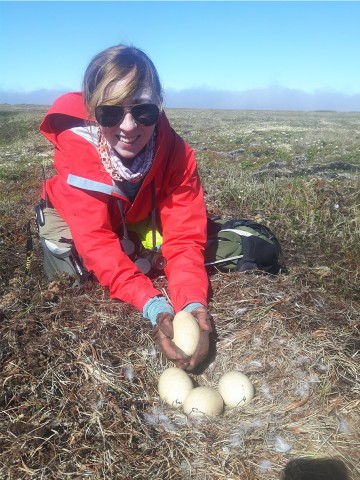Our next ‘Best Mining Story’ comes to us from Carlie Stransky, Ecologist, Kupol, who shares a story about her month-long expedition working at Chaun Biological Research Station, located on a remote island in the Chaun Delta in Russia’s Far East. This story highlights the important role that Kinross is playing locally to help bird migration and ecological research.
“Three biology students from North-East State University (in Magadan) and myself spent the month of July working at Chaun Biological Research Station, an isolated camp on Ayopechan Island in the Chaun Delta.
My journey began on a helicopter, with a heavy backpack loaded with a month’s worth of field gear. As I got out of the helicopter, I took a moment to take in my surroundings. I’m standing on the edge of the Pucheveem River near several wood cabins amongst beautiful mountains. I met part of the crew that I would be spending the next four weeks with and we quickly got to work unloading donations from Kinross, such as camp supplies and food, and brought them into the main cabin.
This research station is one of 17 throughout the Arctic taking part in the “Arctic Shorebird Demographic Network” project. Supported by the Wildlife Conservation Society, the project helps to understand how species who migrate to the Arctic from all over the world respond to climate change. Since 2010, Kinross has helped make these studies possible by providing flights to the remote station from Magadan and Pevek, supplying food, and even a drone. This year was the first year that Kinross sponsored a team of students to help with their studies.
The Intergovernmental Panel on Climate Change predicts that the tundra habitat in Chukotka will remain, although they expect a consistent loss of tundra in Alaska. This emphasizes the need to incorporate Chukotka in long-term conservation programs, since it is expected that habitat will be lost in Alaska. The Chukotka area is important for breeding during the summer months for bird species who migrate to South Africa, China and Australia. Understanding the population growth of these bird species helps scientists understand world-wide environmental conditions.
During the month-long project we had limited electricity and no Internet. We were free from distractions of the ‘outside world’ and kept busy by hiking around 12 kilometres a day studying nest survival, counting species of birds, and collecting blood samples for DNA analysis. We also enjoyed the local scenery and enjoyed activities including fishing and visiting a nearby village called Rytkuchy.
This one-of-a-kind experience will never be forgotten.”

Carlie monitoring a Bewick’s Swan nest

Lead scientist Diana Solovyeva and paleo-geographer Sergey Vartanyan observe a Pacific Loon nest off the live feed from the drone donated by Kinross. The drone helps the team conduct surveys in hard to reach areas.

Carlie (centre in the red coat) at the summit of Mount Neitlin with the other students



